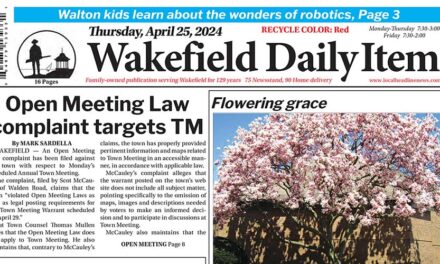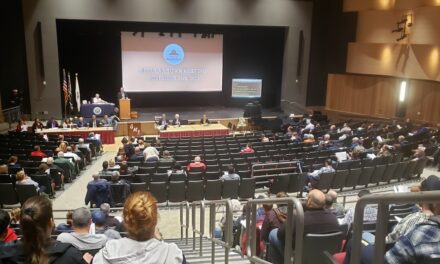Published in the October 20, 2017 edition
By MARK SARDELLA
WAKEFIELD – The Conservation Commission last night got its first chance to hear about and weigh in on the proposed underground electric transmission line that would run through 3.6 miles of Wakefield on its way to the National Grid Power Station off Montrose Avenue.
Originally unveiled in 2015, the proposed project is part of an 8.5 mile underground 345KV transmission line that would run from the Eversource substation on Cove Street in Woburn, through Winchester, Stoneham and Wakefield.
The purpose of the project is to maintain the integrity of the bulk power system and to ensure that adequate transmission services are available to meet current and future load demand in the region.
While it is a joint project of National Grid and Eversource, the applicant of record for Wakefield permitting is National Grid.
Dave Klinch, a wetland scientist with Epsilon Associates, represented National Grid at last night’s opening hearing before the Conservation Commission.
Klinch said that the 3.6 miles in Wakefield will include 2.65 miles in the public roadway and just under one mile along an inactive railroad bed. There will also be about six manholes evenly spaced along the Wakefield portion, Klinch said.
If the project obtains the required local and state approvals, National Grid hopes to start work in Wakefield in late winter or early spring 2018. Construction on the project would take about 18 months.
Klich said that the project would have no direct impact on any vegetated wetland. He said that there would be about 13,000 square feet of work in the riverfront area (primarily the Mill River) and about 41,000 square feet in the buffer zone (half in the railroad bed, half outside the railroad). He said that no work would occur in protected habitat areas.
Following the route of the line, he said that it would go through about 200 feet of buffer zone for Crystal Lake, then enter the old railroad right of way Iin the Junction area). The line will then follow the old rail line across Main Street in front of the Galvin Middle School and out to Water Street. When the line reaches Salem Street it would go under the Mill River and continue down Salem Street to Montrose Avenue.
Within the old rail right of way is where some work is near the Mill River BVW (bordering vegetated wetland), Klich said.
He explained that the underground transmission line will consist of three cables inside a pipe enclosed within a concrete duct bank. He said that the trench enclosing the concrete duct bank would be three feet wide and six to eight feet deep. The top of the duct bank would be two feet underground. Soil dug up from the trench will be trucked away, he said.
Asked by a ConCom member about hazardous waste within the railroad right of way, Klinch said that those soils have been tested and they were “not atypical” of railroad soils, but he noted that that data is owned by the MBTA (the owner of the railroad right of way).
Conservation Agent Elaine Vreeland wanted to know if there would be a licensed site professional to evaluate hazardous soil conditions. Klinch said that there would be an LSP overseeing the entire project.
He said that the only place that any trees or saplings will need to be removed will be in areas where they’ve grown up within the old railroad bed.
Any remaining rails and ties will be removed, Klinch said, and a paved access road will be installed along that stretch of the project. That section of the railroad right of way is also part of a proposed rail trail, Klinch explained, and Naticnal Grid has agreed to construct the access road according to standards requested by the town of Wakefield for a future rail trail.
Klinch said that the route through Wakefield selected by National Grid was the route preferred by the town of Wakefield, which had asked National Grid to stay away from Main Street and North Avenue as much as possible. It was also the route that received the best environmental score, he said.
Klinch said that National Grid has been working closely with Wakefield officials, including DPW Director Richard Stinson and Town Engineer Michael Collins, since the proposal was announced two years ago and that cooperation would continue.
He said that the town has made its expectations clear should the project go forward.




